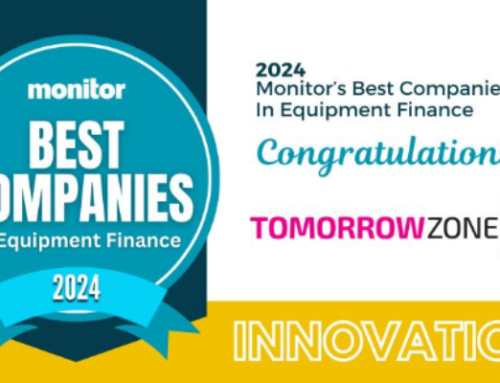
As promised, TomorrowZone® kicked off this year’s Equipment Leasing and Finance Association (ELFA) Innovation Roundtable Series with a bang! The first discussion took place on February 15, 2024, where we explored the hot topic of: Navigating the Digital Frontier: Overcoming Barriers to Innovation, hosted by Deborah Reuben.
Featuring panelists: Tawyna Stone, Lisa Fitzgerald, Moto Tohda, and special guest Leigh Lytle to kick it off, the conversation was riveting. Together, this incredible panel shared insights and strategies on overcoming the challenges of transformational initiatives. Discussion focused on the “messy middle” phase of implementation, the pros and cons of agile and waterfall methodologies, the vital importance of leadership and communication, and the crucial need for a clear scope and objectives.
Attendees came from diverse backgrounds, each bringing unique perspectives and experiences to the table. From innovation leaders to CEOs of tech companies, the group discussed challenges, strategies, and best practices for driving successful technology projects forward.
Discussion was centered on the “Messy Middle,” which is the phase in transformational projects characterized by uncertainty and challenges that require adaptive strategies and continuous learning for all involved.
In case you missed it, check out a few key takeaways as we discussed how to navigate the “messy middle”:
- Humanizing Innovation: Innovation should not only focus on technology but also on understanding and addressing the human aspect of technological adoption and change management.
- Overcoming Fear of Failure: Overcoming the fear of failure is essential for fostering a culture that encourages experimentation and learning from failures, critical for innovation.
- Importance of Shared Understanding: Achieving a shared understanding among team members about project goals, expectations, and definitions of success is critical for navigating the messy middle effectively.
- Agile vs. Waterfall: The choice between Agile and Waterfall methodologies depends on the project’s nature and requirements, with Agile offering flexibility and Waterfall providing structured planning. It is important to choose the right method for each project there is no “one size fits all.”
- Leadership in Innovation: Strong leadership is essential for guiding teams through the messy middle, ensuring alignment with project goals, and maintaining momentum. It’s a continuous process, not an event.
- Emotional Intelligence in Deployment: Emotional intelligence plays a significant role in technology deployment, facilitating user adoption and addressing concerns throughout the process.
- Continuous Learning and Adaptation: Adopting a mindset of continuous learning and adaptation helps teams navigate uncertainty and embrace change more effectively.
- Leveraging Small, Focused Projects: Implementing small, focused projects can shorten the messy middle by providing clarity and enabling quicker adaptation to innovative technologies.
Occasionally, when things seem to be going off the rails, or your team members are dealing with fear, you, as a leader need to stop, reframe and reset so that your team can continue forward with clarity. Here are some steps to help when you need to STOP and Re-evaluate.
- Communicate continually.
- Acknowledge the current state of the project and communicate it clearly to the team.
- Utilize visual tools to ensure everyone is on the same page and draft documents together.
- Encourage team members to bring their own ‘snacks’ and ‘music’ to make the journey through the messy middle more enjoyable.
- Emphasize the importance of communication and adapt the message to the audience’s current mindset for better outcomes.
- Consider the project’s complexity and scope to determine the appropriate methodology (Agile or Waterfall).
- Focus on continuous learning and empower team members to apply critical thinking.
- Make tough decisions early to address potential issues and avoid scope creep.
- Develop a shared language and understanding around the project’s goals and measures of success.
Advice from Lisa Fitzgerald, Director, Business Capital Technology, First Citizens Bank Equipment Finance:
- Set Realistic Expectations of Success
- Balance Technology Initiatives and Production Issues: Use strong prioritization and get everyone on the same page.
- Losing Sight of the Project Goal is a Risk. Don’t become so detail-oriented that the broader project goals are lost. It’s important to maintain focus on the ultimate objective.
- Manage the Human Aspect of Change. Many technology-related changes are less about the technology itself and more about managing the human aspects, such as team dynamics and individual responses to change. It is vital to set realistic expectations, define measures of success, and ensure common understanding among team members.
- Communication and Terminology: Have clear communication and understanding of terms like ‘agile’ and ‘waterfall’. Misuse or misunderstanding of these terms and others can lead to confusion and misaligned expectations. Focus on listening, manage expectation, and use the messy middle phase of the project as an opportunity for growth and learning.
Advice from Tawnya Stone, VP Strategic Technology, GreatAmerica Financial Services Corp.
- Manage Expectations during technology projects, particularly in the messy middle where outcomes may not align with the initial exceptions.
- Communicate. Don’t assume your message was received and understood the first time. It is often necessary to repeat information in various formats and times to ensure it is received and understood.
- Perspective and Context: Consider different perspectives and contexts, especially when changes affect not just the team but also customers, leading to multiple messy middles. Consider the customer’s perspective and keep in mind that both the company and the customer might be experiencing their own versions of the messy middle, which requires careful consideration and management.
Advice from Moto Tohda, VP of Information Systems, Tokyo Century (USA) Inc.
- Balance preparation with execution. Over-preparing can delay project starts, while under-preparing can lead to gaps in understanding and execution as the project progresses.
- Continually evaluate success measures. As projects evolve, initial success measures may no longer align with current goals, leading to a messy middle where expectations and outcomes start to diverge. This can cause projects to become overly complex as they evolve.
- Cleary identify the problem to solve. Initiating the project based on a trend (e.g. automation) without properly identifying the actual problem to solve leads to ineffective solutions and potential project failure.
- Intervene early in projects to identify and address issues before they escalate.
A big thank you to everyone for helping us continue to #makeawesomehappen! We look forward to the remaining round table discussions in this year’s series. Be sure to save the following dates and join us in 2024: May 9, August 8, November 21. We hope to see you there!
We at TomorrowZone® expect incredible innovation opportunities to come about in 2024 for the EF industry and beyond. As we discussed in this roundtable, the journey from conception to completion is often filled with twists, turns, and unforeseen challenges. You don’t have to navigate it alone. Let us help you to be future ready!





